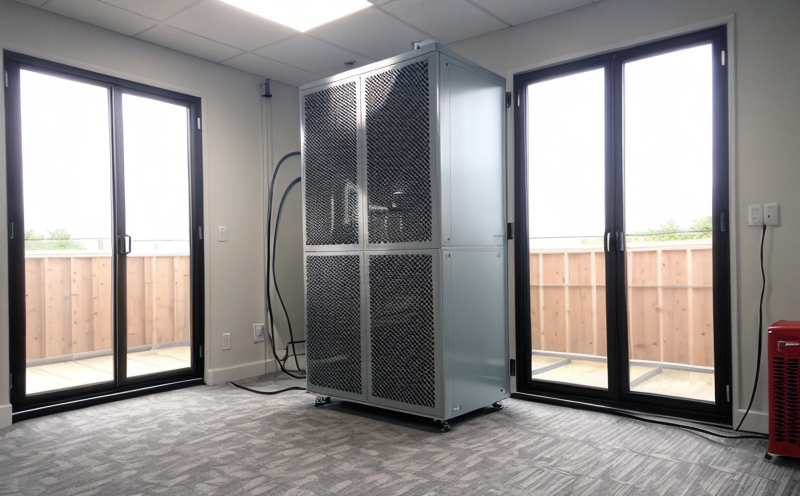DIN 1946-6 Ventilation Flow Performance
The DIN 1946-6 standard is one of the most widely recognized and applied norms in the HVAC (Heating, Ventilation, and Air Conditioning) sector. It provides comprehensive guidelines for testing the ventilation flow performance of HVAC systems to ensure they meet specified design requirements. This service focuses on verifying that the ventilation system operates efficiently as intended by measuring airflow rates through ducts, diffusers, and grilles.
The primary objective of DIN 1946-6 is to ensure that installed HVAC equipment performs optimally in terms of air distribution and flow rates within a building. This is critical for maintaining indoor air quality (IAQ), energy efficiency, and comfort levels. The testing procedure outlined by DIN 1946-6 involves several key steps:
- Selection of appropriate test sections
- Measurement of static pressure at various points in the ductwork
- Determination of airflow rates using pitot tubes or other suitable instruments
- Evaluation against design specifications and acceptance criteria
- Documentation of results for future reference or regulatory compliance
The accuracy and repeatability of these measurements are paramount, as they directly influence the overall performance of the HVAC system. By adhering to DIN 1946-6, organizations can ensure that their facilities meet both local regulations and international best practices.
| Step | Action | Objective |
|---|---|---|
| Select test sections | Determine which parts of the ductwork will be tested for flow rates | Ensure representative areas are chosen to reflect real-world conditions |
| Measure static pressure | Record pressures at different points using manometers or similar devices | Analyze resistance within the system to identify potential inefficiencies |
| Determine airflow rates | Utilize instruments like pitot tubes or hot-wire anemometers | Evaluate whether actual flow matches design expectations |
| Evaluate against specifications | Compare measured values with the HVAC system's design data | Determine compliance with established performance standards |
| Document results | Compile all findings into a detailed report | Provide clear evidence of testing and adherence to DIN 1946-6 requirements |
The process outlined in DIN 1946-6 ensures that HVAC systems are not only installed correctly but also operate efficiently throughout their lifecycle. This is particularly important for large commercial buildings, industrial complexes, and public spaces where maintaining optimal IAQ is essential.
At Eurolab, our commitment to quality and precision extends beyond mere compliance with international standards like DIN 1946-6. We offer a range of benefits that set us apart in the field of HVAC testing:
- State-of-the-art facilities: Our laboratories are equipped with cutting-edge technology, ensuring accurate and reliable test results.
- Experienced professionals: Our team comprises highly skilled engineers who possess in-depth knowledge of HVAC systems.
- Comprehensive testing services: We provide a full suite of testing options to cover all aspects of HVAC performance.
- Fast turnaround times: Clients receive their test reports promptly, allowing for timely adjustments if necessary.
By choosing Eurolab for your DIN 1946-6 ventilation flow performance tests, you can be assured that your systems will meet the highest standards of efficiency and reliability. Our services are tailored to meet the needs of various stakeholders, including quality managers, compliance officers, R&D engineers, and procurement specialists.
Environmental and Sustainability Contributions
The testing procedures prescribed by DIN 1946-6 play a crucial role in promoting environmental sustainability. By ensuring that HVAC systems operate efficiently, these tests help reduce energy consumption and lower greenhouse gas emissions associated with heating and cooling processes.
Efficient ventilation systems contribute significantly to reducing the carbon footprint of buildings. Proper airflow management not only enhances indoor air quality but also minimizes the need for excessive mechanical interventions, thereby conserving resources such as electricity and water.
Moreover, DIN 1946-6 testing supports compliance with various environmental regulations and certifications. Many green building initiatives require proof that HVAC systems perform at optimal levels to achieve certification status. By adhering to these standards, organizations can demonstrate their commitment to sustainability while also benefiting from improved operational efficiency and reduced costs.
At Eurolab, we understand the importance of environmental stewardship in our industry. Our services are designed to help clients not only meet current regulatory requirements but also anticipate future trends in sustainable building practices.
Use Cases and Application Examples
- New construction projects: Ensuring that newly installed HVAC systems comply with design specifications before occupancy.
- Retrofit installations: Verifying the performance of existing systems after modifications or repairs have been made.
- Facility management: Regularly testing and maintaining HVAC systems to ensure they continue to meet operational needs.
- Licensing and certification: Providing necessary documentation for regulatory bodies during licensing applications or recertification processes.
| Use Case | Description | Outcome |
|---|---|---|
| New construction projects | Testing ventilation flow performance before occupancy to ensure proper operation and comfort levels. | Achieve compliance with local building codes and provide peace of mind for facility managers. |
| Retrofit installations | Evaluating changes in airflow due to modifications or repairs, ensuring continued efficiency despite alterations. | Verify that updates do not negatively impact system performance while maintaining energy savings. |
| Facility management | Conducting periodic tests to monitor ongoing performance and identify areas for improvement. | Promote longevity of HVAC systems, enhance operational efficiency, and reduce maintenance costs. |
| Licensing and certification | Gathering data needed for licensing or recertification processes, ensuring compliance with all relevant regulations. | Facilitate smooth submission of applications and minimize delays in obtaining necessary approvals. |





